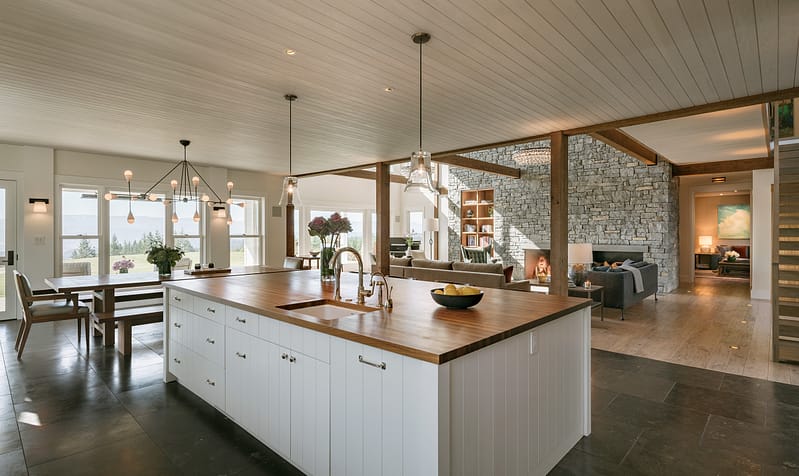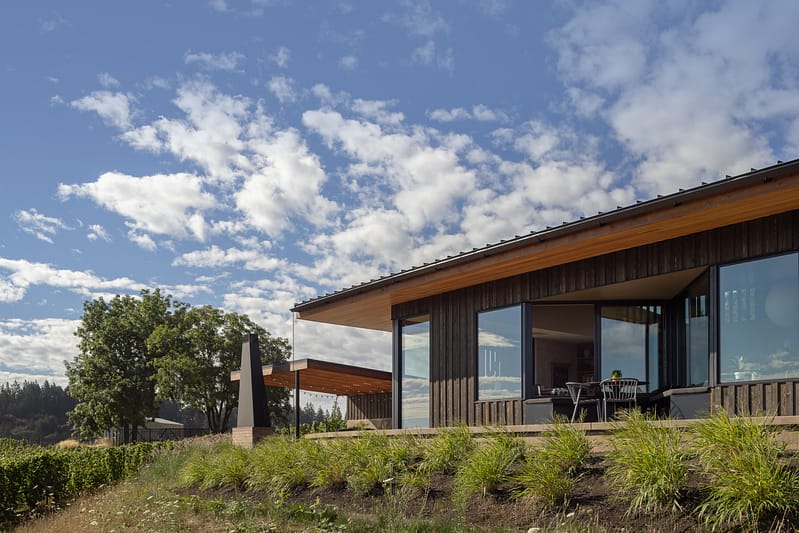Choosing the right flooring is an important step during a kitchen remodel. There are a lot of options on the market and the interior designer or architect on the project is the best resource for making the choice. Sometimes people like to come to the table with a little background information on some of the most commonly used flooring materials to better make the selection for their project. Below we’ve put together a quick look at some of the pros and cons of seven popular kitchen flooring materials.
Bamboo
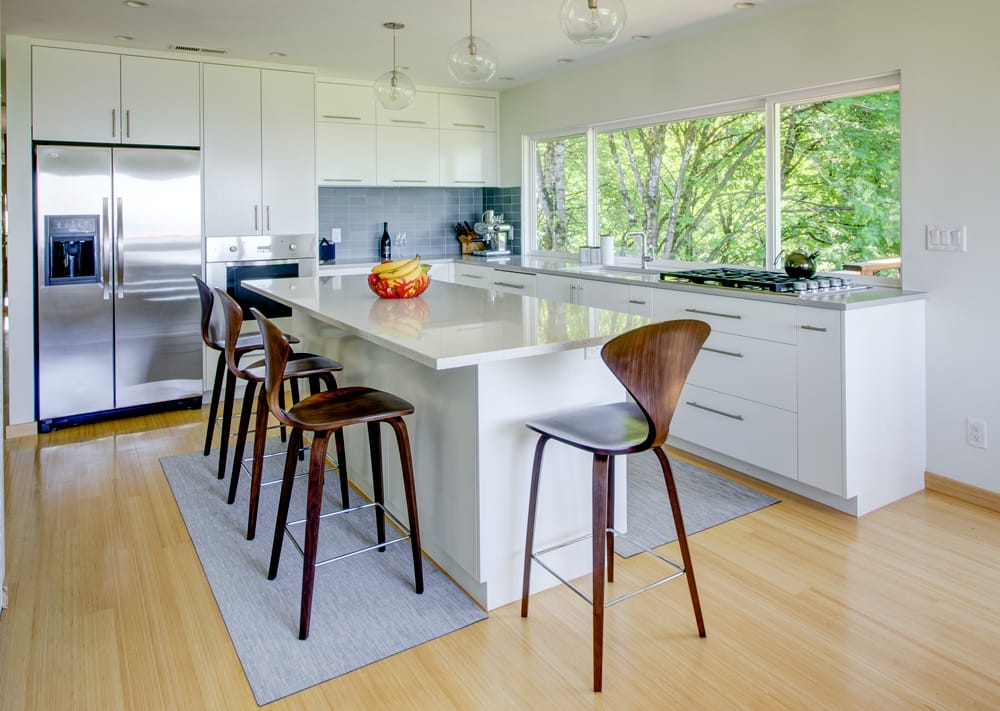
Bamboo, Healy Heights Remodel
Bamboo can come in a variety of colors from natural (blonde) to stained (any color) or carbonized (dark brown). It’s also a less expensive alternative to traditional hardwood floors (bamboo is actually a grass).
Pros:
- Very durable.
- Sustainable material – if the source is known.
- Easy to maintain.
- A little more water resistant than wood.
Cons:
- Prone to scratches.
- Can swell or crack in very dry or very humid climates.
Cork
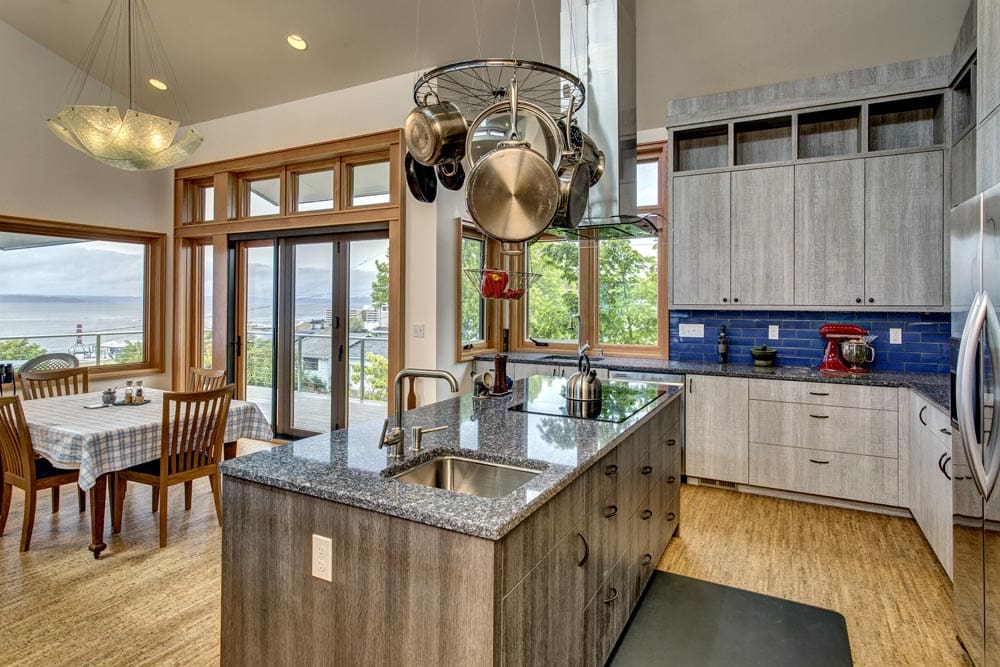
Seville Cork in Bamboo, Ballard Locks Remodel
Cork has been gaining popularity lately because of its eco-friendly and foot-friendly characteristics. While there isn’t a huge range of options aesthetically, this material’s natural, neutral palette fits in most homes.
Pros:
- Eco-friendly. Cork forests are ancient and bio-diverse. One tree can live hundreds of years with its cork bark being harvested every 9-10 years.
- Soft on feet.
- Slip-resistant.
- Moisture resistant.
- Dishes are less likely to break if dropped.
Cons:
- Needs to be re-sealed every 3-4 years to guard against scratches and moisture entering seams between tiles.
- Can fade over time.
- Vulnerable to scratches.
Porcelain Tile

Pental Studio Gray Matte Porcelain Tile, Sylvan Highlands Remodel
Porcelain tile is a great option for people who want a strong material that will last a long time with little maintenance. It comes in a huge variety of colors and patterns – even wood grain to mimic hardwood floors.
Pros:
- Very durable.
- Low maintenance.
- Comes in a variety of styles.
- Impervious to moisture.
- Great option for installing over radiant floor heating.
Cons:
- Can be dangerous when wet, ask for the slip resistant variety.
- Can be hard on the feet after long periods of cooking.
- Grout will need to be re-sealed.
Ceramic tile is another good option, with the same pros and cons as porcelain tile. However, it is not as durable as porcelain tile. It can also crack as floors settle. Some prefer natural stone tile, which is a beautiful option but is also more prone to staining and scratching.
Wood
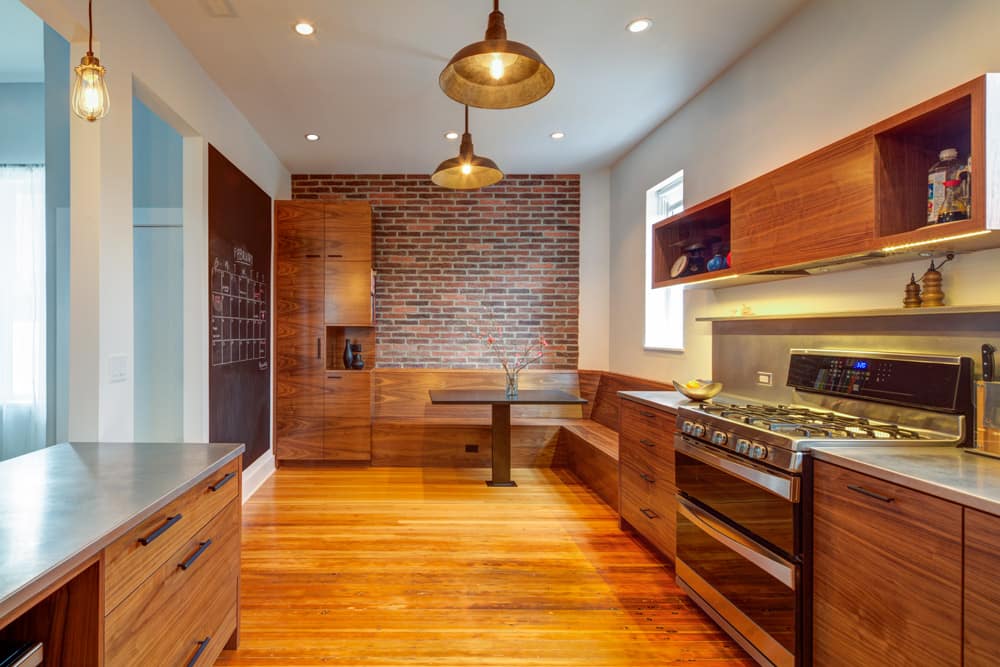
Wood is a classic material that brings warmth into a kitchen and keeps the space from looking dated. It’s a particularly good choice if you have an open floor plan with wood floors throughout the rest of the home.
Pros:
- Looks great in any style home.
- A classic material that won’t ever look dated.
- Comes in a variety of colors, board sizes, and grain patterns.
Cons:
- Moisture can be a problem. Spills should be wiped up right away to avoid warping and other damage.
- Dents and scratches easily (but it’s just as easy to fix up with some sanding and refinishing).
- Very limited choices of species over radiant floor heating – the wrong wood will shrink and swell with the heating/cooling process.
Vinyl
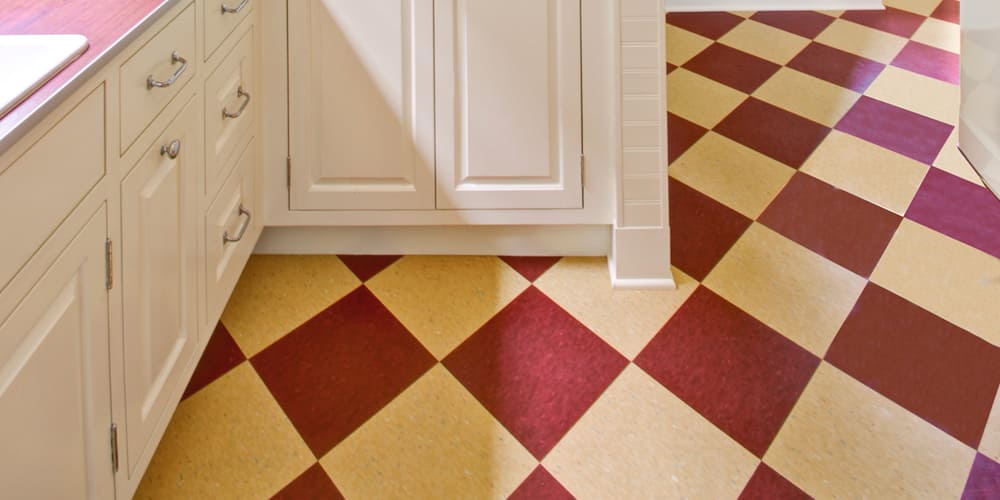
Vinyl Composition Tiles from Armstrong in Maraschino and Buttercream Yellow, Retro Kitchen
Vinyl has been around for decades, and for good reason. It’s a very affordable, easy option. While it may not last as long as other materials, it is an economical option that is not too difficult to replace when the time comes.
Pros:
- Can look like other materials but at a lower cost.
- Easy to clean.
- Vinyl tiles can be easily replaced if damaged.
Cons:
- Can dent, bubble, or curl over time.
- Not very durable.
- Not a good option over radiant heat flooring – the heat can discolor the vinyl.
Linoleum
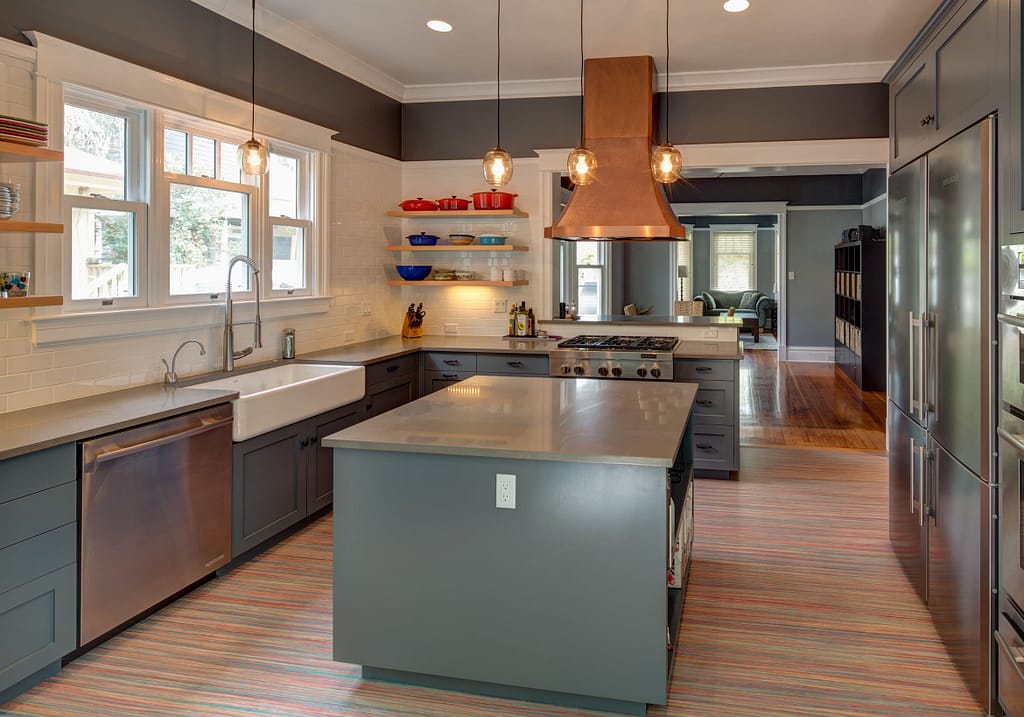
Marmoleum, King Kitchen Remodel
Linoleum is a great material for when you want something a little different. It comes in a variety of color and patterns, like the rainbow striped Marmoleum (a brand name for linoleum flooring) seen above, making it a good option for kitchens that need a little color and interest. Comes in sheets and tiles.
Pros:
- Eco-friendly.
- Easy to maintain.
- Durable if properly maintained.
- Wide variety of colors and patterns available.
- Comfortable underfoot.
- Historically appropriate.
Cons:
- Can fade and wear over time.
- Can get torn or scratched.
- Can yellow over time when exposed to sunlight.
Concrete
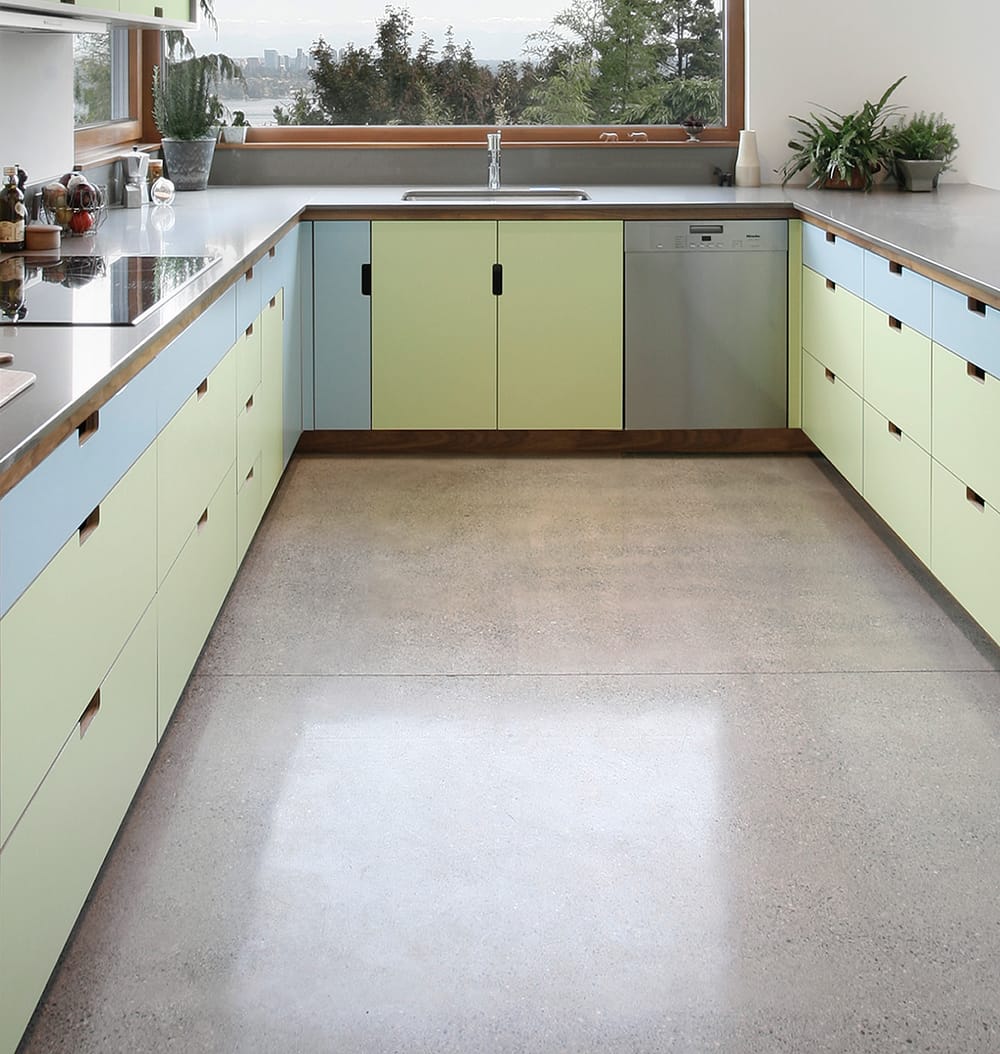
Concrete, Madrona Passive House
Concrete is a great material – incredibly strong and looks great in modern spaces. It can be stained and polished to give it a wide variety of looks (you don’t have to go with classic gray, like above).
Pros:
- Stays cool in hot weather (good for hot climates).
- Very durable.
- Can always use it as a subfloor if you want to change it up later.
Cons:
- Can feel cold and industrial.
- Porous, so must be sealed to keep it from staining.
- Can develop hairline cracks (just aesthetic, not structural).
Check out our other kitchen materials post, 7 Most Popular Countertop Materials for Kitchen Remodels for some information about countertops.


